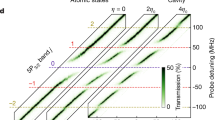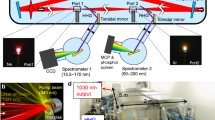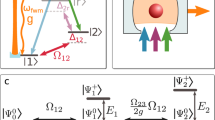Abstract
The spectral purity of an oscillator is central to many applications, such as detecting gravity waves1, defining the second2,3, ground-state cooling and quantum manipulation of nanomechanical objects4, and quantum computation5. Recent proposals6,7,8,9 suggest that laser oscillators which use very narrow optical transitions in atoms can be orders of magnitude more spectrally pure than present lasers. Lasers of this high spectral purity are predicted to operate deep in the ‘bad-cavity’, or superradiant, regime, where the bare atomic linewidth is much less than the cavity linewidth. Here we demonstrate a Raman superradiant laser source in which spontaneous synchronization of more than one million rubidium-87 atomic dipoles is continuously sustained by less than 0.2 photons on average inside the optical cavity. By operating at low intracavity photon number, we demonstrate isolation of the collective atomic dipole from the environment by a factor of more than ten thousand, as characterized by cavity frequency pulling measurements. The emitted light has a frequency linewidth, measured relative to the Raman dressing laser, that is less than that of single-particle decoherence linewidths and more than ten thousand times less than the quantum linewidth limit typically applied to ‘good-cavity’ optical lasers10, for which the cavity linewidth is much less than the atomic linewidth. These results demonstrate several key predictions for future superradiant lasers, which could be used to improve the stability of passive atomic clocks3 and which may lead to new searches for physics beyond the standard model11,12.
This is a preview of subscription content, access via your institution
Access options
Subscribe to this journal
Receive 51 print issues and online access
$199.00 per year
only $3.90 per issue
Buy this article
- Purchase on Springer Link
- Instant access to full article PDF
Prices may be subject to local taxes which are calculated during checkout




Similar content being viewed by others
References
Cagnoli, G. et al. Very high Q measurements on a fused silica monolithic pendulum for use in enhanced gravity wave detectors. Phys. Rev. Lett. 85, 2442–2445 (2000)
Ludlow, A. D. et al. Sr lattice clock at 1 × 10−16 fractional uncertainty by remote optical evaluation with a Ca clock. Science 319, 1805–1808 (2008)
Jiang, Y. Y. et al. Making optical atomic clocks more stable with 10−16-level laser stabilization. Nature Photon. 5, 158–161 (2011)
Teufel, J. D. et al. Sideband cooling of micromechanical motion to the quantum ground state. Nature 475, 359–363 (2011)
Leibfried, D., Blatt, R., Monroe, C. & Wineland, D. Quantum dynamics of single trapped ions. Rev. Mod. Phys. 75, 281–324 (2003)
Meiser, D., Ye, J., Carlson, D. R. & Holland, M. J. Prospects for a millihertz-linewidth laser. Phys. Rev. Lett. 102, 163601–163604 (2009)
Chen, J. Active optical clock. Chin. Sci. Bull. 54, 348–352 (2009)
Meiser, D. & Holland, M. J. Steady-state superradiance with alkaline-earth-metal atoms. Phys. Rev. A 81, 033847–033850 (2010)
Meiser, D. & Holland, M. J. Intensity fluctuations in steady-state superradiance. Phys. Rev. A 81, 063827–063833 (2010)
Schawlow, A. L. & Townes, C. H. Infrared and optical masers. Phys. Rev. 112, 1940–1949 (1958)
Blatt, S. et al. New limits on coupling of fundamental constants to gravity using 87Sr optical lattice clocks. Phys. Rev. Lett. 100, 140801–140804 (2008)
Fortier, T. M. et al. Precision atomic spectroscopy for improved limits on variation of the fine structure constant and local position invariance. Phys. Rev. Lett. 98, 070801–070804 (2007)
Hartnett, J. & Nand, N. Ultra-low vibration pulse-tube cryocooler stabilized cryogenic sapphire oscillator with 10−16 fractional frequency stability. IEEE Trans. Microw. Theory Tech. 58, 3580–3586 (2010)
Young, B. C., Cruz, F. C., Itano, W. M. & Bergquist, J. C. Visible lasers with subhertz linewidths. Phys. Rev. Lett. 82, 3799–3802 (1999)
Kolobov, M. I., Davidovich, L., Giacobino, E. & Fabre, C. Role of pumping statistics and dynamics of atomic polarization in quantum fluctuations of laser sources. Phys. Rev. A 47, 1431–1446 (1993)
Kuppens, S. J. M., van Exter, M. P. & Woerdman, J. P. Quantum-limited linewidth of a bad-cavity laser. Phys. Rev. Lett. 72, 3815–3818 (1994)
Wang, H., Goorskey, D. J., Burkett, W. H. & Xiao, M. Cavity-linewidth narrowing by means of electromagnetically induced transparency. Opt. Lett. 25, 1732–1734 (2000)
Dicke, R. H. Coherence in spontaneous radiation processes. Phys. Rev. 93, 99–110 (1954)
Kleppner, D., Goldenberg, H. M. & Ramsey, N. F. Theory of the hydrogen maser. Phys. Rev. 126, 603–615 (1962)
Benmessai, K. et al. Measurement of the fundamental thermal noise limit in a cryogenic sapphire frequency standard using bimodal maser oscillations. Phys. Rev. Lett. 100, 233901–233904 (2008)
Kuppens, S., van Exter, M., Woerdman, J. & Kolobov, M. Observation of the effect of spectrally inhomogeneous gain on the quantum-limited laser linewidth. Opt. Commun. 126, 79–84 (1996)
Björk, G., Heitmann, H. & Yamamoto, Y. Spontaneous-emission coupling factor and mode characteristics of planar dielectric microcavity lasers. Phys. Rev. A 47, 4451–4463 (1993)
Vrijsen, G., Hosten, O., Lee, J., Bernon, S. & Kasevich, M. A. Raman lasing with a cold atom gain medium in a high-finesse optical cavity. Phys. Rev. Lett. 107, 063904–063907 (2011)
Hilico, L., Fabre, C. & Giacobino, E. Operation of a cold-atom laser in a magneto-optical trap. Europhys. Lett. 18, 685–688 (1992)
Guerin, W., Michaud, F. & Kaiser, R. Mechanisms for lasing with cold atoms as the gain medium. Phys. Rev. Lett. 101, 093002–093005 (2008)
Chan, H. W., Black, A. T. & Vuletić, V. Observation of collective-emission-induced cooling of atoms in an optical cavity. Phys. Rev. Lett. 90, 063003–063006 (2003)
Chen, Z., Bohnet, J. G., Sankar, S. R., Dai, J. & Thompson, J. K. Conditional spin squeezing of a large ensemble via the vacuum Rabi splitting. Phys. Rev. Lett. 106, 133601–133604 (2011)
McKeever, J., Boca, A., Boozer, A. D., Buck, J. R. & Kimble, H. J. Experimental realization of a one-atom laser in the regime of strong coupling. Nature 425, 268–271 (2003)
Leibrandt, D. R., Thorpe, M. J., Bergquist, J. C. & Rosenband, T. Field-test of a robust, portable, frequency-stable laser. Opt. Express 19, 10278–10286 (2011)
Acknowledgements
We thank J. Ye and A. M. Rey for discussions. J.G.B., Z.C., J.M.W. and J.K.T. acknowledge support from NSF PFC, NIST and ARO. M.J.H. and D.M. acknowledge support from the DARPA QuASaR programme through a grant from ARO and from NSF. J.G.B. acknowledges support from NSF GRF, and Z.C. acknowledges support from A*STAR Singapore.
Author information
Authors and Affiliations
Contributions
J.G.B., Z.C., J.M.W. and J.K.T. designed and built the experiment. J.G.B. and Z.C. performed the measurements. J.G.B., Z.C., J.M.W. and J.K.T. analysed the results. D.M., M.J.H. and J.K.T. provided the theoretical analysis. J.G.B. and J.K.T. wrote the manuscript. All authors discussed the results and text of the manuscript.
Corresponding author
Ethics declarations
Competing interests
The authors declare no competing financial interests.
Supplementary information
Supplementary Information
This file contains Supplementary Text that expands on details in the original paper, comprising: Experimental Details; Primary Experimental Configuration; Secondary Experimental Configuration; Atom Loss; Photon Number and Phase Uncertainty; Phasor Correlation; and Lorentzian Fits. The file also includes Supplementary Figures 1-2, which are detailed diagrams of the physical experimental setup and atomic energy levels. (PDF 489 kb)
Rights and permissions
About this article
Cite this article
Bohnet, J., Chen, Z., Weiner, J. et al. A steady-state superradiant laser with less than one intracavity photon. Nature 484, 78–81 (2012). https://doi.org/10.1038/nature10920
Received:
Accepted:
Published:
Issue Date:
DOI: https://doi.org/10.1038/nature10920
This article is cited by
-
Collectively enhanced Ramsey readout by cavity sub- to superradiant transition
Nature Communications (2024)
-
Many-body cavity quantum electrodynamics with driven inhomogeneous emitters
Nature (2023)
-
A non-equilibrium superradiant phase transition in free space
Nature Physics (2023)
-
The development of active optical clock
AAPPS Bulletin (2023)
-
Polariton Phenomena in Superradiant Lasing with a Low-Q Asymmetric Fabry–Perot Cavity
Radiophysics and Quantum Electronics (2023)
Comments
By submitting a comment you agree to abide by our Terms and Community Guidelines. If you find something abusive or that does not comply with our terms or guidelines please flag it as inappropriate.



